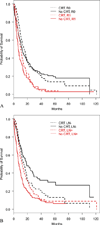Adjuvant chemoradiation therapy for pancreatic adenocarcinoma: who really benefits?
- PMID: 19476845
- PMCID: PMC4167601
- DOI: 10.1016/j.jamcollsurg.2008.12.020
Adjuvant chemoradiation therapy for pancreatic adenocarcinoma: who really benefits?
Abstract
Background: The role of adjuvant chemoradiation therapy (CRT) in pancreatic cancer remains controversial. The primary aim of this study was to determine if CRT improved survival in patients with resected pancreatic cancer in a large, multiinstitutional cohort of patients.
Study design: Patients undergoing resection for pancreatic adenocarcinoma from seven academic medical institutions were included. Exclusion criteria included patients with T4 or M1 disease, R2 resection margin, preoperative therapy, chemotherapy alone, or if adjuvant therapy status was unknown.
Results: There were 747 patients included in the initial evaluation. Primary analysis was performed between patients that had surgery alone (n=374) and those receiving adjuvant CRT (n=299). Median followup time was 12.2 months and 14.5 months for survivors. Median overall survival for patients receiving adjuvant CRT was significantly longer than for those undergoing operation alone (20.0 months versus 14.5 months, p=0.001). On subset and multivariate analysis, adjuvant CRT demonstrated a significant survival advantage only among patients who had lymph node (LN)-positive disease (hazard ratio 0.477, 95% CI 0.357 to 0.638) and not for LN-negative patients (hazard ratio 0.810, 95% CI 0.556 to 1.181). Disease-free survival in patients with LN-negative disease who received adjuvant CRT was significantly worse than in patients who had surgery alone (14.5 months versus 18.6 months, p=0.034).
Conclusions: This large multiinstitutional study emphasizes the importance of analyzing subsets of patients with pancreas adenocarcinoma who have LN metastasis. Benefit of adjuvant CRT is seen only in patients with LN-positive disease, regardless of resection margin status. CRT in patients with LN-negative disease may contribute to reduced disease-free survival.
Figures




Similar articles
-
Prognostic factors and adjuvant chemoradiation therapy after pancreaticoduodenectomy for pancreatic adenocarcinoma.J Gastrointest Surg. 2009 Sep;13(9):1699-706. doi: 10.1007/s11605-009-0969-5. Epub 2009 Jul 7. J Gastrointest Surg. 2009. PMID: 19582512
-
Addition of radiotherapy to adjuvant chemotherapy is associated with improved overall survival in resected pancreatic adenocarcinoma: An analysis of the National Cancer Data Base.Cancer. 2015 Dec 1;121(23):4141-9. doi: 10.1002/cncr.29652. Epub 2015 Aug 17. Cancer. 2015. PMID: 26280559
-
Adjuvant chemoradiation for pancreatic adenocarcinoma: the Johns Hopkins Hospital-Mayo Clinic collaborative study.Ann Surg Oncol. 2010 Apr;17(4):981-90. doi: 10.1245/s10434-009-0743-7. Epub 2010 Jan 20. Ann Surg Oncol. 2010. PMID: 20087786 Free PMC article.
-
Preoperative chemoradiation in resectable pancreatic cancer.J Hepatobiliary Pancreat Surg. 2003;10(1):61-6. doi: 10.1007/s10534-002-0736-5. J Hepatobiliary Pancreat Surg. 2003. PMID: 12918459 Review.
-
Review of adjuvant radiochemotherapy for resected pancreatic cancer and results from Mayo Clinic for the 5th JUCTS symposium.Int J Radiat Oncol Biol Phys. 2009 Oct 1;75(2):364-8. doi: 10.1016/j.ijrobp.2008.11.069. Int J Radiat Oncol Biol Phys. 2009. PMID: 19735864 Review.
Cited by
-
Radiotherapy as an Adjunct to Surgery for Pancreatic Cancer: Where Are We After More Than 30 Years of Research and Trials?Ann Surg Oncol. 2019 Dec;26(13):4166-4167. doi: 10.1245/s10434-019-07787-w. Epub 2019 Oct 11. Ann Surg Oncol. 2019. PMID: 31605341 Free PMC article. No abstract available.
-
Analysis of 6,747 pancreatic neuroendocrine tumors for a proposed staging system.J Gastrointest Surg. 2011 Jan;15(1):175-83. doi: 10.1007/s11605-010-1380-y. Epub 2010 Nov 20. J Gastrointest Surg. 2011. PMID: 21103949
-
Perioperative Radiation for Patients with Resectable Pancreatic Cancer: an Updated Review After the Initial RTOG 0848 Results.J Gastrointest Cancer. 2025 Feb 22;56(1):70. doi: 10.1007/s12029-025-01185-0. J Gastrointest Cancer. 2025. PMID: 39987276 Review.
-
Predictors of adjuvant treatment for pancreatic adenocarcinoma at the population level.Curr Oncol. 2016 Oct;23(5):334-342. doi: 10.3747/co.23.3205. Epub 2016 Oct 25. Curr Oncol. 2016. PMID: 27803598 Free PMC article.
-
Neoadjuvant and Adjuvant Treatments for Resectable and Borderline Resectable Pancreatic Ductal Adenocarcinoma: The Current Status of Pancreatic Ductal Adenocarcinoma Treatment in Japan.Gut Liver. 2023 Sep 15;17(5):698-710. doi: 10.5009/gnl220311. Epub 2023 Feb 27. Gut Liver. 2023. PMID: 36843421 Free PMC article. Review.
References
-
- Jemal A, Siegel R, Ward E, et al. Cancer statistics, 2006. CA Cancer J Clin. 2006;56:106–130. - PubMed
-
- Geer RJ, Brennan MF. Prognostic indicators for survival after resection of pancreatic adenocarcinoma. Am J Surg. 1993;165:68–73. - PubMed
-
- Kalser MH, Ellenberg SS. Pancreatic cancer. Adjuvant combined radiation and chemotherapy following curative resection. Arch Surg. 1985;120:899–903. - PubMed
Publication types
MeSH terms
Grants and funding
LinkOut - more resources
Full Text Sources
Medical
Research Materials

